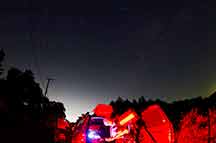

This is a very high rank event, centered on Santa Cruz, and has 11 other observers signed up. In this way, very similar to Gunila 2 weeks earlier. The target star is only 14.0 and the star field is extremely dense with stars, in the Bulge of the Milky Way center in Sagittarius. The altitude =22 degrees Az=157, pretty much due south. It lasts 11.6 seconds, the drop is only 0.4 magnitudes, but with integration and a long duration, this should be quite do-able.
 |
 |
Clear skies for both Kirk, Karl and I. Kirk got a 10.1 sec event from home, I got an 9.0s event from upper Rodeo Gulch. Karl's tape failed to record. Dirty tape heads is seems.
I almost blew this one entirely. I was careful to pack everything well before the event, so I'd have time to focus on taxes and other things before leaving. I printed charts for this and for the Aurora and Mr.Spock events of the next night, and for some reason decided I would not put them all into my usual folder for bringing, but only the one set of charts for Pompeja. But I grabbed the wrong charts, and only discovered this after I was all set up and ready to 2-star align at Rodeo Gulch, 25 minutes before the event. Too late to drive home and try it there. Instead I called Kirk on my cell phone, (which had only 1 or 2 bars), and he sent me charts in a message. I used my iPhone to get the coordinates and ID the star field, barely in time. In fact, I got on target and was taping just 25s before the event, and I was at 32x to help ID stars, but that was too long an integration, and I had ~1-3 saturated pixels on the target, except during the occultation itself when the saturated pixels disappeared. I ended up having to do a 10-aperture set on the target, and noisy unusable data beginning 1 minute after the event had to be trimmed out, in order to get a solid red-bar test. The duration was 9.0 seconds, in decent agreement with Kirk's better data from many miles away in west side Santa Cruz.
The "Run2" folder has the photometry used here. PyOTE log file (there are several attempts at solutions on this file; it's the last one that is best, and shown here).
magDrop report: percentDrop: 20.5 magDrop: 0.249 +/- 0.037 (0.95 ci)
snr: 2.33
D time: [05:23:14.4854]
D: 0.6800 containment intervals: {+/- 0.2227} seconds
D: 0.9500 containment intervals: {+/- 0.8523} seconds
D: 0.9973 containment intervals: {+/- 2.7227} seconds
R time: [05:23:23.5611]
R: 0.6800 containment intervals: {+/- 0.2227} seconds
R: 0.9500 containment intervals: {+/- 0.8523} seconds
R: 0.9973 containment intervals: {+/- 2.7227} seconds
Duration (R - D): 9.0757 seconds
Duration: 0.6800 containment intervals: {+/- 0.3573} seconds
Duration: 0.9500 containment intervals: {+/- 1.2071} seconds
Duration: 0.9973 containment intervals: {+/- 3.0377} seconds
|
PyMovie composite of all light curves. I included 3 reference stars. And, 10 aperture sizes on the target. 3.2px gave the best reductions; this one included ~all the target light, with very little sky within the aperture. |
PyOTE reduction, using ref2 star to calibrate. Ref2 gave the best reductions. It too had ~1-3 saturated pixels, and was close to the target, so perhaps this was why it gave the cleanest occultation photometry. |
Zoomed in. |
The red bar test, passed. |
|
from my observing site at the top of Rodeo Gulch Rd, at the spot with the eastern view |
 |
 |
|
PyMovie composite of light curves |
The target light, in PyMovie |
Target and a reference star used in the reduction |
Zoomed in |
Passes the red bar test |
The recording failed; probably dirty tape heads. It's good practice to do a very short recording well before the event and play back to make sure it really did record. And failing that, to record off the external monitor with an iPhone or other camera.